Animal Facts
Protecting Endangered Animal Species: Our Duty
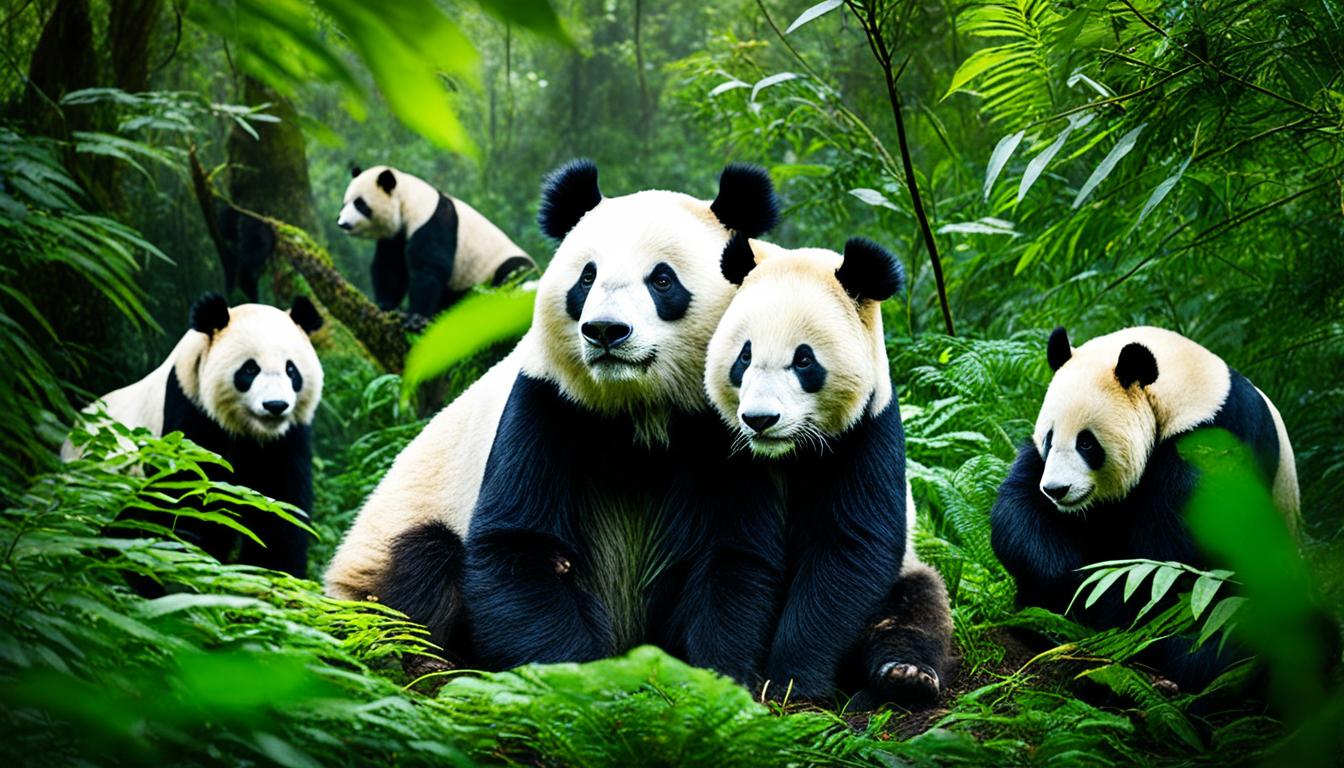
Were you aware that the rate of extinction of species has vastly accelerated, placing us in the midst of the planet’s sixth mass extinction event? This alarming reality necessitates immediate action to safeguard endangered animal species and conserve biodiversity. As conscientious caretakers of our planet, it is incumbent upon us to protect these species and guarantee a healthier and more secure future for ecosystems and humanity.
Key Takeaways:
- Protecting endangered animal species is not just an ethical obligation but a necessity for the health of our planet
- The extinction rate of species has significantly increased, leading to the sixth mass extinction
- Preserving endangered species is crucial for maintaining biodiversity and ensuring the stability of ecosystems
- Our duty to protect endangered species extends beyond our own interests and encompasses the health and stability of the planet
- By taking collective action, we can make a significant difference in preserving endangered animal species and their habitats
Why Should We Protect Endangered Animals?
Endangered species play a vital role in maintaining biodiversity. Each species contributes to the intricate balance of nature, ensuring the health and stability of ecosystems. When species become endangered or go extinct, it disrupts this balance and can have far-reaching effects on other species. Additionally, endangered species can serve as indicators of environmental health, highlighting underlying issues such as habitat destruction, pollution, and climate change. By protecting endangered animals, we safeguard the wellbeing of entire ecosystems.
Endangered animals are not just individual beings struggling for survival; they are integral components of a larger tapestry that sustains the planet. The interconnectedness of different species forms a delicate web of life, where each species plays a unique role. The loss of one species can have cascading effects on others, disrupting the finely tuned balance that has developed over millions of years.
By protecting endangered animals, we are not only safeguarding their future but also preserving the biodiversity and environmental health of our planet.
Conserving endangered species is not solely about protecting individual animals or plants—it is about protecting the intricate complex of relationships and interactions that contribute to a healthy and functioning ecosystem. These ecosystems provide us with clean air, fresh water, fertile soil, and vital resources for our survival and well-being. When we protect endangered animals, we are also protecting ourselves and future generations.
Furthermore, endangered species act as environmental indicators, giving us valuable insights into the health of ecosystems. Their decline or disappearance can signal the presence of deeper underlying issues such as habitat destruction, pollution, or climate change. By paying attention to the plight of endangered animals, we can address the root causes and take action to restore balance and ensure the long-term sustainability of our environment.
Protecting endangered animals is not just a duty; it is an investment in the future of our planet and the generations to come.
The Impact of Endangered Species on Climate Change
Biodiversity plays a crucial role in the fight against climate change. Preserving endangered species is not only essential for the well-being of these individual species but also for the health of our planet as a whole. Biodiverse ecosystems contribute to regulating temperatures, sequestering carbon dioxide, and support the resilience of ecosystems in the face of climate impacts.
When biodiversity is reduced due to habitat destruction or species loss, ecosystems become more vulnerable and compromised. The loss of key species disrupts the natural functions that contribute to climate adaptation and mitigation. Protecting endangered species is, therefore, vital to mitigating climate change and preserving the natural functions that maintain the balance of our ecosystems.
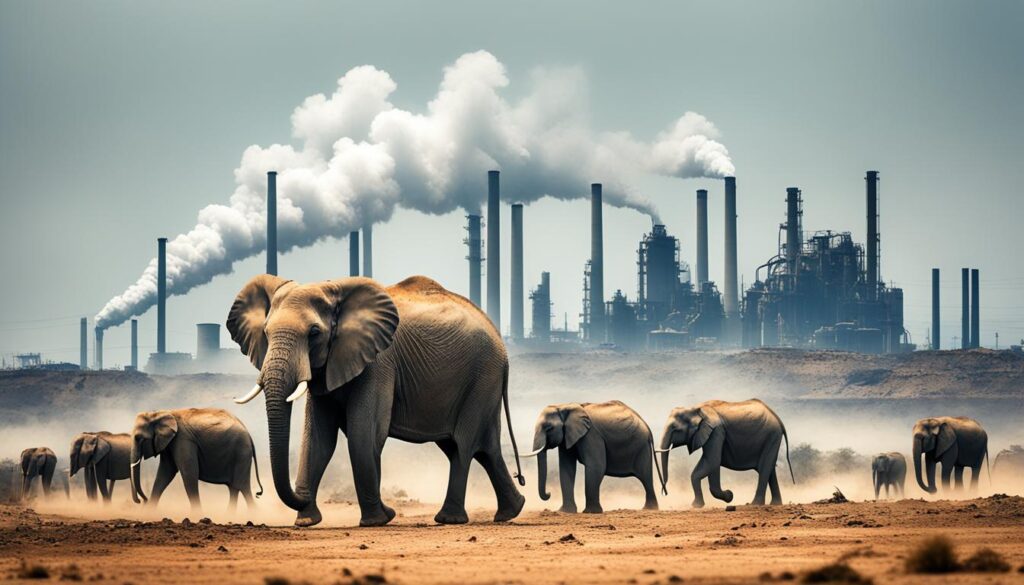
| Natural Functions of Endangered Species in Climate Change Mitigation | Effects of Biodiversity Loss on Climate Change |
|---|---|
| Regulation of temperatures | Decreased resilience to climate impacts |
| Sequestration of carbon dioxide | Reduced carbon storage capacity |
| Enhanced ecosystem resilience | Inability to adapt to changing climate conditions |
| Support for climate adaptation | Disruption of natural climate regulation |
The Role of Endangered Species as Ecosystem Engineers
Some endangered animals serve as “ecosystem engineers,” actively contributing to the protection and maintenance of their environments. Through their feeding behaviors and other ecological roles, these species play a crucial role in creating balance within their habitats and sustaining the intricate food webs that support diverse ecosystems.
For instance, sharks, despite being vulnerable themselves, act as regulators of prey populations in marine ecosystems. Their presence helps maintain the delicate balance of the food webs, preventing the overgrowth of certain prey species and promoting biodiversity.
Elephants, another example of ecosystem engineers, play a vital role in dispersing seeds as they move across their habitats. By consuming fruits and excreting seeds in different locations, elephants contribute to the creation of new habitats and the growth of diverse plant species.
“Sharks and elephants are just a few examples of endangered species that act as ecosystem engineers. By understanding their ecological roles and safeguarding their populations, we can preserve the delicate balance of our habitats and ensure the sustainability of our ecosystems.”
Seals are also instrumental in maintaining balance within marine food webs. They serve as both predators and prey, occupying a unique position in the ecological chain. Their presence contributes to nutrient cycling, as they consume marine organisms and excrete waste on coastal habitats, fertilizing the surrounding environment.
The conservation of these endangered species is of utmost importance in sustaining ecosystems and preserving the delicate balance that supports a wide array of life forms. By protecting the ecosystem engineers, we safeguard habitats, uphold the intricate food webs that maintain biodiversity, and ensure the long-term resilience of our planet.
The Cultural Significance of Endangered Species
Endangered species are not just essential for ecological reasons; they also hold tremendous cultural and traditional significance for many communities around the world. The preservation of these species is vital for safeguarding cultural heritage and traditions that have been deeply intertwined with nature for centuries.
One example of such cultural significance can be seen in the beliefs of the Mazahua people in Mexico. They consider the Monarch butterflies, an endangered species, as the spirits of their departed loved ones. These beautiful creatures play a significant role in their spiritual rituals, symbolizing the connection between life and death.
“The Monarch butterflies are our ancestors, returning to guide us onto our spiritual journey, reminding us of our connection to nature and the cycle of life,” says Maria Hernandez, a Mazahua elder.
Additionally, the African savannah elephants have deep cultural connections with indigenous communities across Africa. These majestic creatures represent wisdom, strength, and a profound connection to their people. They are often central figures in traditional stories, dances, and ceremonies, playing a vital role in preserving cultural identity and passing down ancestral knowledge from one generation to another.
By protecting endangered species like the Monarch butterflies and African savannah elephants, we not only ensure the continuity of valued cultural traditions but also foster a deeper appreciation for the rich biodiversity that surrounds us.
The Cultural Significance: A Source of Unity and Pride
Endangered species are not only biological treasures but also symbols of cultural unity and pride. They unite communities, empowering them to protect their customs, rituals, and shared heritage rooted in the natural world.
Moreover, the conservation of these species provides an opportunity for intergenerational exchange, with elders sharing their traditional knowledge and younger generations gaining a deeper understanding of the connection between culture and the environment.
We must recognize that the cultural significance of endangered species extends beyond their ecological value. Preserving these species is an essential part of preserving cultural diversity and ensuring the passing on of tangible and intangible cultural heritage to future generations.
| Endangered Species | Cultural Significance |
|---|---|
| Monarch butterflies | Viewed as the spirits of the dead by the Mazahua people in Mexico |
| African savannah elephants | Deep cultural connections and symbols of wisdom and connection to indigenous groups |
Human Activities as a Threat to Endangered Species
The sixth mass extinction event is primarily caused by human activities such as habitat destruction, deforestation, pollution, overexploitation, introduction of invasive species, and climate change. These activities have led to widespread biodiversity loss and the decline or extinction of numerous species. It is our responsibility to protect endangered species and the environments they inhabit through behavioral changes, policy changes, and urgent international action.
“The ongoing destruction of habitats and overexploitation of natural resources are threatening the delicate balance of ecosystems and pushing many species to the brink of extinction. It is crucial that we recognize the impact of our actions and work towards sustainable solutions to mitigate the threats faced by endangered species.” – Dr. Rachel Johnson, Wildlife Conservation Scientist
The Impact of Habitat Destruction
Habitat destruction is one of the leading threats to endangered species. As human populations grow and expand, natural habitats are being cleared for agriculture, urban development, and infrastructure projects. This destruction disrupts ecosystems and displaces species, often leading to their decline or extinction. Without intact and diverse habitats, endangered species struggle to find food, shelter, and breeding grounds, further impacting their survival.
Overexploitation and its Consequences
Overexploitation, which includes activities such as hunting, fishing, and illegal trade, poses a significant threat to endangered species. When species are overharvested or poached beyond their reproductive capacity, their populations decline rapidly. Species like elephants, rhinos, and tigers are particularly vulnerable to overexploitation for their ivory, horns, and skins. This unsustainable demand threatens their survival and disrupts ecosystems.
The Role of Climate Change
Climate change, largely caused by human activities, is a major threat to endangered species. Rising temperatures, changing weather patterns, and sea-level rise directly impact the habitats and food sources of many species. From coral bleaching that devastates delicate marine ecosystems to the loss of polar bear habitats due to melting ice, climate change poses a significant risk to biodiversity. Urgent action is needed to reduce greenhouse gas emissions and mitigate the effects of climate change.
The Importance of Awareness and Education
Increasing awareness about the consequences of human activities on endangered species is vital. By educating ourselves and others, we can promote responsible behavior, sustainable practices, and conservation efforts. Engaging in eco-friendly practices, supporting local initiatives, and advocating for stronger environmental policies are essential steps towards protecting endangered species and mitigating the threats they face.
| Human Activities | Impact on Endangered Species |
|---|---|
| Habitat destruction | Displacement and decline |
| Deforestation | Loss of key habitats, disruption of ecosystems |
| Pollution | Contamination of water, air, and soil |
| Overexploitation | Population decline, endangerment, and extinction |
| Introduction of invasive species | Competition and predation on native species |
| Climate change | Habitat loss, disrupted ecosystems, increased extinction risk |
Protecting endangered species requires a collective effort to address the root causes of their decline. It is our duty to prioritize conservation, adopt sustainable practices, and advocate for stronger environmental policies to ensure a brighter future for both endangered species and our planet as a whole.
Taking Action to Protect Endangered Species
As conscious stewards of our environment, we have the power to make a difference in protecting endangered species and preserving biodiversity. Every small action we take collectively contributes to the larger cause of safeguarding these vulnerable animals and their habitats. Here are several impactful ways we can actively protect endangered species:
- Rewilding Gardens: By creating wildlife-friendly gardens, we can provide essential habitats for pollinators and other endangered species. Planting native flowers, shrubs, and trees, and avoiding the use of pesticides, we help create sanctuaries that support biodiversity.
- Participating in Beach Cleanups: Joining community beach cleanup initiatives is an effective way to protect marine species and their habitats. By cleaning up our beaches and coastal areas, we prevent harmful debris from polluting the ocean and endangering wildlife.
- Choosing Eco-Friendly Products: Opting for eco-friendly cleaning products, sustainable household items, and responsibly sourced materials minimizes our ecological footprint. Supporting brands that prioritize environmentally friendly practices helps protect endangered species and their habitats.
- Reducing Meat Consumption: Embracing meat-free dinners or incorporating more plant-based meals into our diet significantly reduces the demand for animal agriculture. This conscious choice helps mitigate habitat destruction, deforestation, and greenhouse gas emissions associated with livestock production, ultimately protecting endangered species.
- Supporting Wildlife Conservation Experts: Contributing to reputable wildlife conservation organizations and supporting the dedicated experts in the field allows us to help protect endangered species more effectively. Financial contributions, volunteering, or participating in awareness campaigns assist in funding essential research, conservation programs, and advocacy efforts.
Our collective efforts to protect endangered species can have a significant impact on preserving biodiversity and ensuring a sustainable future for our planet. By taking these actions, we actively contribute to the conservation efforts aimed at safeguarding these remarkable creatures and the delicate ecosystems they inhabit.
Quote:
“The smallest act of kindness towards an animal is a step towards a better world for all living beings.” – Unknown
| Action | Impact |
|---|---|
| Rewilding Gardens | Provides essential habitats for pollinators and endangered species. |
| Participating in Beach Cleanups | Protects marine species and prevents pollution of coastal habitats. |
| Choosing Eco-Friendly Products | Minimizes environmental impact and supports sustainable practices. |
| Reducing Meat Consumption | Helps mitigate habitat destruction and greenhouse gas emissions. |
| Supporting Wildlife Conservation Experts | Provides valuable resources for research, programs, and advocacy. |
The Importance of Captive Breeding in Species Conservation
Captive breeding programs play a crucial role in the conservation of endangered species. These programs are designed to maintain and revive populations that have lost their natural habitats due to factors such as habitat loss and degradation, climate change, and human activities.
Through captive breeding, animals can be bred in controlled environments, ensuring their survival and preventing their complete extinction. This approach provides a safety net for species at risk and allows for the possibility of reintroducing them to their natural habitats when suitable conditions are restored.
It is important to note that while captive breeding programs offer temporary solutions, they are not a replacement for addressing the root causes of species decline. The continued loss of natural habitats remains a significant threat to endangered species, and comprehensive conservation efforts must tackle issues such as habitat loss, illegal wildlife trade, and unsustainable human practices.
Captive breeding programs are most effective when integrated with wider conservation strategies that prioritize habitat protection and restoration. By addressing the underlying factors contributing to species decline, we can work towards long-term species recovery and the preservation of biodiversity.
The Benefits of Captive Breeding
Captive breeding programs provide several benefits for the conservation of endangered species:
- Population Preservation: By breeding animals in captivity, we can maintain populations and prevent species from going extinct.
- Genetic Diversity: Through careful breeding management, captive programs can help preserve genetic diversity within species, reducing the risk of inbreeding and maintaining healthy populations.
- Education and Research: Captive breeding programs offer opportunities for scientific research and public education, enabling us to learn more about these species and raise awareness about their conservation needs.
It is crucial to prioritize the well-being and ethical treatment of animals involved in captive breeding programs. Stringent regulations and guidelines are in place to ensure the proper care, enrichment, and welfare of captive individuals.

Case Study: Arabian Oryx Conservation
One notable success story of captive breeding is the conservation of the Arabian oryx, a species once classified as extinct in the wild. Through coordinated international efforts and captive breeding programs, the Arabian oryx population has been successfully restored in its native range.
| Year | Wild Population | Captive Population |
|---|---|---|
| 1972 | 0 | 19 |
| 2021 | 2,000+ | Over 7,000 |
“The captive breeding efforts for the Arabian oryx demonstrate that with proper conservation strategies and international collaboration, we can reverse the fortunes of endangered species and restore their populations to healthy levels in the wild.” – Dr. Maria Rodriguez, Wildlife Conservation Society
The Need for International Collaboration in Species Conservation
Protecting endangered species requires international collaboration and cooperation. While international organizations like the International Union for Conservation of Nature (IUCN) play a critical role in bringing attention to species conservation, the real conservation work happens at the national and local levels. It involves dialogue, political will, and implementing effective conservation strategies. By working together, we can address the global threats to biodiversity and ensure the long-term survival of endangered species.
The challenges faced by endangered species transcend borders, requiring a united effort from countries around the world. International collaboration allows us to combine our knowledge, resources, and expertise to implement comprehensive conservation measures. By sharing best practices, research findings, and technological advancements, we can develop more effective strategies for species conservation and environmental protection.
Key Benefits of International Collaboration
- Enhanced Biodiversity Protection: International collaboration enables the conservation of endangered species across their entire range. By coordinating efforts, we can conserve habitats, protect migratory pathways, and implement initiatives that span multiple countries. This integrated approach ensures the long-term viability of species and fosters healthy ecosystems.
- Shared Responsibility: Endangered species are not constrained by national borders. Their survival depends on the collective actions of diverse countries and stakeholders. By fostering international collaboration, we acknowledge our shared responsibility and work collectively towards ensuring the continued existence of endangered species.
- Knowledge Exchange and Capacity Building: Collaboration provides an opportunity for countries to share knowledge, scientific research, and management strategies. This exchange of information facilitates capacity building, allowing countries to enhance their conservation initiatives through shared expertise and learn from successful conservation programs around the world.
- Policy Harmonization: International collaboration helps align conservation policies and frameworks across nations. Through dialogue and negotiation, countries can develop common goals and standards, creating a cohesive approach to species conservation and environmental protection.
- Funding Opportunities: Collaboration opens avenues for greater funding opportunities for species conservation. International partnerships can leverage financial resources from multiple sources, including government grants, philanthropic organizations, and public-private partnerships. This increased funding enables the implementation of larger-scale conservation projects and the development of sustainable solutions.

International collaboration is essential in addressing the complex and interconnected challenges faced by endangered species. It allows us to pool our resources, knowledge, and efforts, maximizing the impact of conservation initiatives. By working together, we can preserve biodiversity, protect ecosystems, and secure a sustainable future for both current and future generations.
The Uncertain Future of Endangered Species
Despite some conservation efforts yielding positive results, the future of endangered species remains uncertain. The relentless forces of habitat loss, climate change, and other detrimental human activities continue to threaten these vulnerable animals. As a result, the risk of extinction looms large, casting a shadow over their survival.
This uncertain future stems from the widespread habitat loss experienced by endangered species. Human activities, such as deforestation, urbanization, and industrialization, have significantly reduced the available habitats for many species. Without suitable habitats, these animals struggle to find food, reproduce, and thrive in their natural environments.
The loss of biodiversity also contributes to the endangered species’ precarious situation. Each species plays a unique role in maintaining the delicate balance of ecosystems. When a species disappears, it disrupts the intricate web of interactions within the ecosystem, potentially leading to cascading effects throughout the food chain and ecosystem function.
Furthermore, the looming threat of climate change exacerbates the challenges faced by endangered species. Rising temperatures, changing weather patterns, and altered habitats directly impact their ability to survive and adapt. The uncertainty of these environmental changes intensifies the risk of extinction for species already on the brink.
Urgent action is crucial to protect and conserve endangered species. Raising awareness about the threats they face is essential in fostering a collective sense of responsibility and inspiring action. Implementing stringent conservation measures, such as habitat restoration, protected areas, and sustainable resource management, can help mitigate habitat loss and provide a lifeline for these species.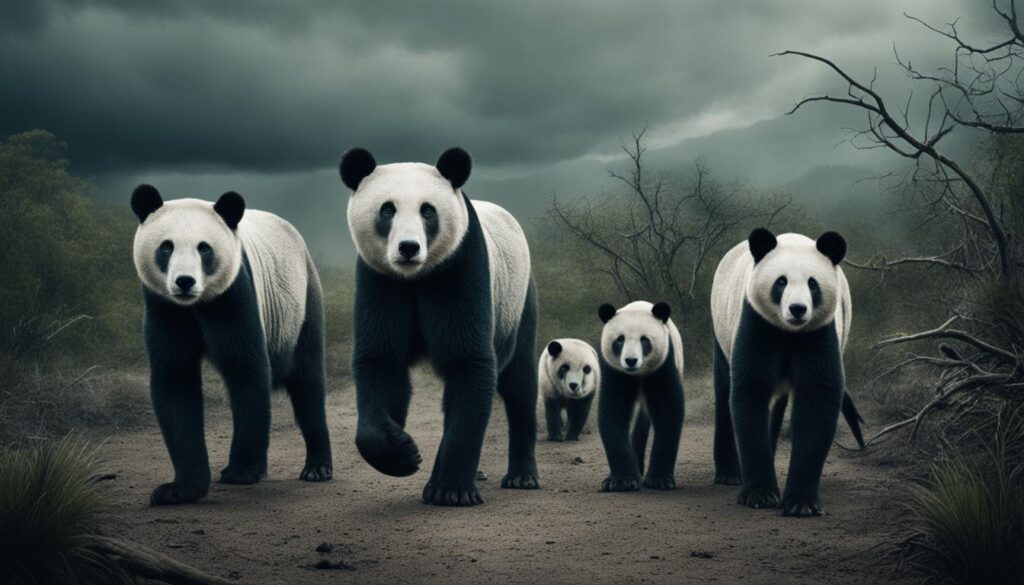
Preserving and restoring wildlife habitats is an invaluable step towards securing the future of endangered species. By safeguarding these habitats, we create safe havens where these animals can thrive, reproduce, and contribute to the overall health and resilience of ecosystems.
The Urgency of Biodiversity Conservation
Biodiversity is the web of life that sustains us all. The loss of species threatens the functionality of ecosystems and compromises our own well-being. It is our duty to protect and conserve endangered species for the sake of our planet and future generations.
Through international cooperation, strict legislation, and sustainable practices, we can address the root causes of habitat loss, reduce the impact of climate change, and minimize the extinction risk faced by endangered species.
Together, we can secure a more certain future for these remarkable creatures and safeguard the irreplaceable biodiversity that enriches our planet.
Making a Difference: How Individuals Can Help
Protecting endangered wildlife is a collective responsibility, and individuals can play an integral role in making a difference. By taking action, we can contribute to the preservation of endangered species and their habitats. Here are some ways you can help:
- Volunteer: Get involved with local zoos or conservation organizations. Volunteer opportunities may include assisting in animal care, participating in habitat restoration projects, or educating the public about endangered species.
- Donate: Support reputable wildlife conservation efforts with financial contributions. Your donations can help fund vital research, habitat protection initiatives, and conservation projects aimed at safeguarding endangered wildlife.
- Raise Awareness: Participate in awareness campaigns to educate others about the importance of protecting endangered species. Share information on social media, organize community events, or give presentations at schools and organizations to spread the word.
- Support Environmental Policies: Advocate for policies that prioritize environmental protection and conservation. Stay informed about local and national initiatives, contact legislators, and join organizations working towards sustainable practices and wildlife conservation.
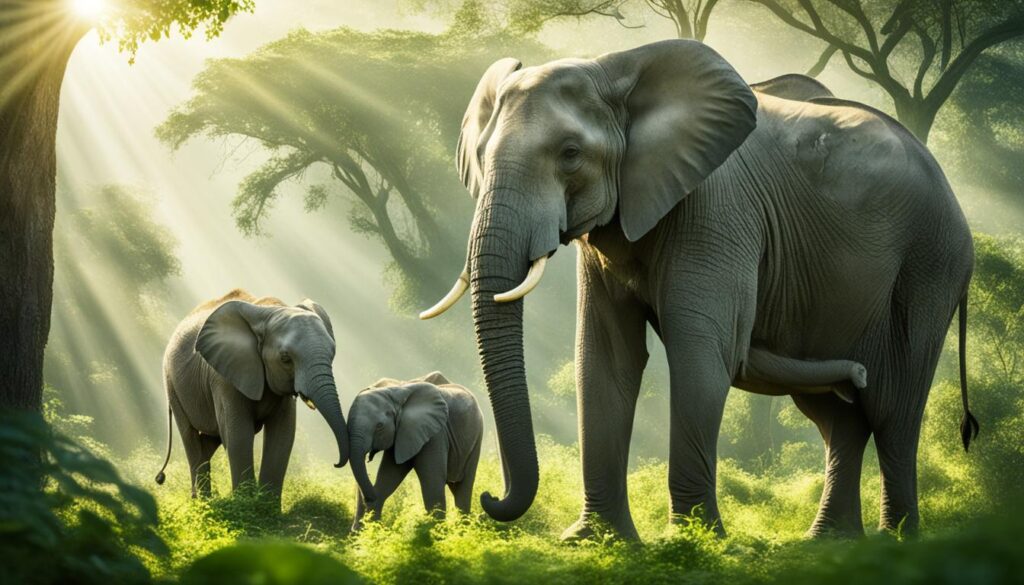
The Ethical Duty to Protect Endangered Species
The preservation of endangered species is not merely a choice; it is an ethical duty that stems from our understanding of the intrinsic value of all living beings and the interconnectedness of ecosystems. Endangered species hold inherent worth and contribute to the delicate balance of biodiversity, which is essential for maintaining the health and stability of our planet.
Our duty to protect endangered species extends beyond human interests and encompasses the preservation of the natural world as a whole. By conserving these species and their habitats, we ensure the continuation of vital ecological processes and the well-being of countless other organisms that rely on them.
“The ethical duty to protect endangered species is grounded in our recognition that every living being deserves respect and has a right to exist.”
The Intrinsic Value of Endangered Species
Endangered species possess inherent value, independent of their utilitarian or economic significance to humans. Each species represents a unique evolutionary heritage, contributing to the richness and complexity of life on Earth. When a species teeters on the brink of extinction, a vital part of our planet’s natural history and diversity is at risk of being forever lost.
The Preservation of Biodiversity
Protecting endangered species is essential for preserving biodiversity, which is the foundation of healthy ecosystems. Biodiversity increases ecosystem resilience, enhances ecosystem services, and promotes stability in the face of environmental changes. By safeguarding endangered species, we safeguard the intricate web of life that supports us all.
The Conservation of Ecosystems
Endangered species serve as integral components of ecosystems, contributing to their proper functioning and stability. Each species plays a unique role in maintaining ecological balance, such as pollination, seed dispersal, and predator-prey relationships. When these species decline or disappear, the delicate equilibrium of ecosystems is disrupted, leading to cascading effects on other species and ecological processes. Conserving endangered species ensures the preservation of healthy and functioning ecosystems.
The Maintenance of Planet’s Health and Stability
Endangered species, as indicators of ecosystem health, serve as a barometer for the overall well-being of our planet. Their decline or disappearance often signifies underlying issues such as habitat destruction, pollution, and climate change. By protecting endangered species, we address these root causes and strive toward a more sustainable future for both the natural world and ourselves.
| Benefits of Protecting Endangered Species | Threats to Consider |
|---|---|
| Preservation of biodiversity | Habitat destruction |
| Maintenance of ecosystem balance | Climate change |
| Promotion of ecological resilience | Overexploitation |
| Indication of environmental health | Invasive species |
The preservation and conservation of endangered species should be viewed as our moral obligation—an ethical duty to protect the remarkable diversity of life on Earth and safeguard the future of our planet.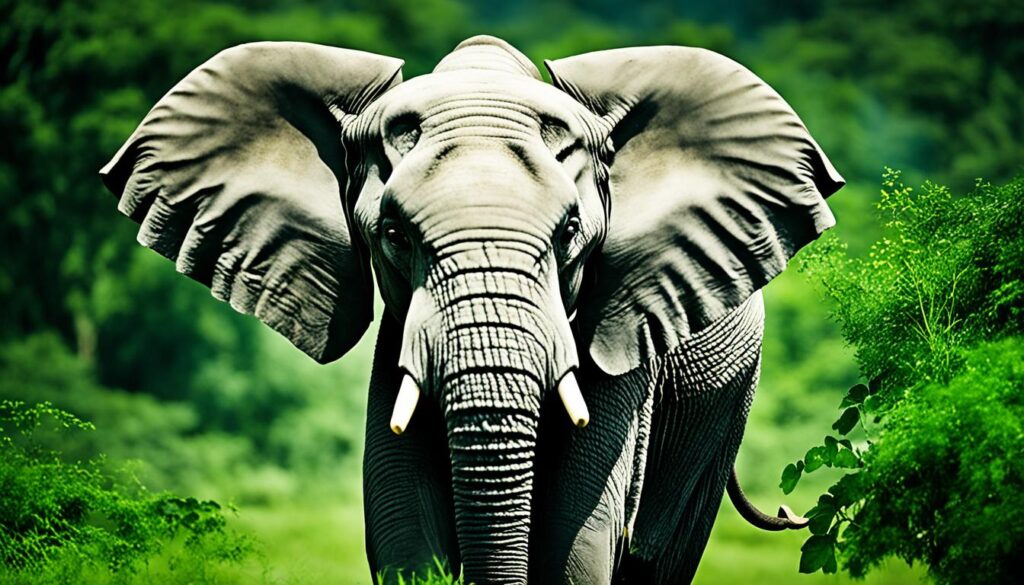
The Role of Science and Research in Species Conservation
Science and research are integral components of successful species conservation efforts. Through rigorous scientific studies, we gain a deeper understanding of the threats that endangered species face, enabling us to develop effective conservation strategies and monitor the progress of our conservation efforts.
Research plays a pivotal role in informing policy decisions related to species conservation. By examining data and empirical evidence, policymakers can make well-informed choices that prioritize the protection and preservation of endangered species. Scientific research also helps raise awareness among the general public about the urgent need for species conservation.
Furthermore, research acts as a catalyst for mobilizing resources and support for species conservation. When we uncover new findings and discoveries through scientific studies, it creates a sense of urgency and inspires individuals, organizations, and governments to take action in protecting endangered species.
“Scientific research is essential in understanding the complex dynamics of ecosystems and the impacts of human activities on endangered species. It provides the foundation for designing effective conservation programs and policies, ensuring a sustainable future for biodiversity.”
Collaboration is key in leveraging the power of science and research to conserve endangered species. Scientists, conservationists, and policymakers must work hand in hand, sharing expertise and knowledge to achieve meaningful conservation outcomes. Through collaboration, we can bridge the gap between research and implementation, translating scientific findings into practical conservation measures that have a positive impact on endangered species.
The Role of Science and Research in Species Conservation:
| Scientific Research | Conservation Strategies | Monitoring Success |
|---|---|---|
| Provides understanding of threats to endangered species | Develops effective conservation strategies | Evaluates the progress of conservation efforts |
| Informs policy decisions | Inspires public awareness and support | Mobilizes resources for conservation |
| Facilitates collaboration between scientists, conservationists, and policymakers | Translates research findings into practical measures | Achieves meaningful conservation outcomes |
By harnessing the power of science and research, we can drive informed decision-making, raise awareness, and implement effective conservation strategies. Together, let us prioritize the role of science in species conservation and ensure a sustainable future for our precious biodiversity.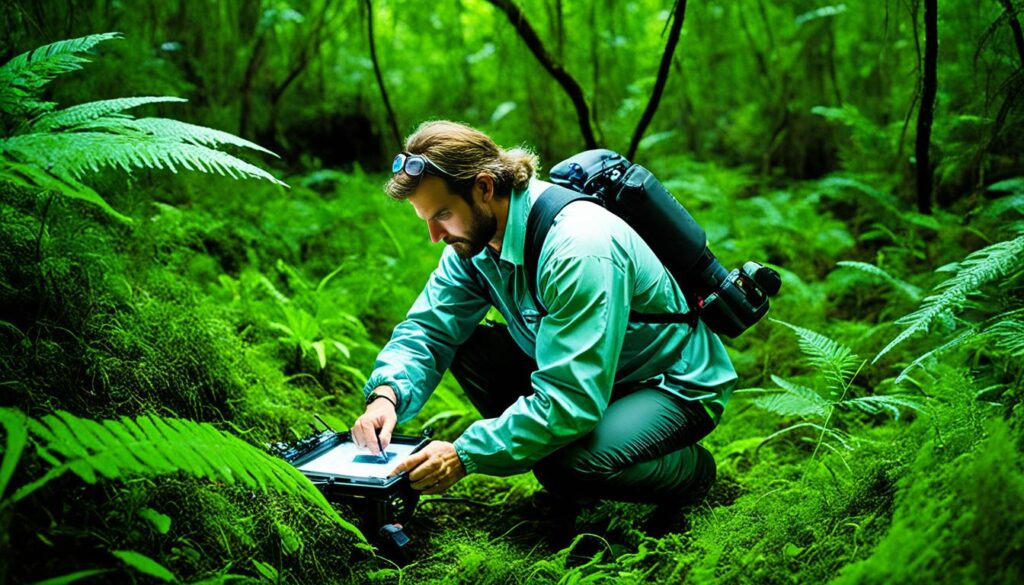
Conclusion
Protecting endangered animal species is not just a moral duty but a necessity for the health and well-being of our planet. The conservation and preservation of biodiversity ensure the long-term survival of ecosystems and the sustainability of our planet.
By taking individual and collective action, we can make a significant difference in protecting endangered species and ensuring a brighter future for generations to come. It is our duty to act now and prioritize the preservation of endangered animal species.
Together, we can create a world where endangered species thrive and contribute to the rich tapestry of life on Earth. Let us join forces, advocate for change, and actively work towards the protection and preservation of these magnificent creatures. The time to act is now.FAQ
Why is protecting endangered animals important?
How do endangered species impact climate change?
What is the role of endangered species as ecosystem engineers?
Do endangered species hold cultural significance?
What are the human activities threatening endangered species?
How can individuals help protect endangered species?
How does captive breeding help endangered species conservation?
Why is international collaboration important in species conservation?
What is the future of endangered species?
How can individuals make a difference in protecting endangered wildlife?
Why is there an ethical duty to protect endangered species?
What is the role of science and research in species conservation?
How Can Protecting Endangered Species Relate to Keeping Pets Safe in Hot Weather?
Protecting endangered species and keeping pets safe in hot weather go hand in hand. By following hot weather pet safety tips, such as providing shade and water, we can protect our pets from heat-related illnesses. Conserving wildlife habitats also ensures the survival of diverse species, creating a balanced ecosystem for all creatures.
Source Links
- https://dailyorange.com/2017/10/saving-endangered-animals-duty-humans/
- https://mountainscholar.org/bitstream/handle/10217/37602/Duties_to_Endangered_Species.pdf
- https://www.ifaw.org/journal/why-should-we-protect-endangered-animals
Dana is our Lead Content Writer, bringing a wealth of knowledge and expertise to our team. With a background deeply rooted in animal studies and a profound love for all creatures, Dana is dedicated to crafting engaging and informative content that resonates with our audience. With Dana at the helm, you can trust that our content is accurate and engaging, catering to the diverse interests of animal enthusiasts everywhere.
Animal Facts
The Impact of Climate Change on Local Wildlife: What You Can Do to Help
Over 60% of local wildlife faces extinction due to climate change—discover simple actions you can take to protect these vulnerable species and their habitats.

Climate change is reshaping local wildlife, putting nearly 60% of species at risk of extinction. You can make a difference by planting native species, which support biodiversity and absorb CO2. Reducing waste by recycling helps lower your carbon footprint. Volunteering at local wildlife refuges aids habitat restoration, while engaging in citizen science contributes valuable insights to conservation efforts. Advocate for protective policies that empower your community's environmental initiatives. Every small action counts in this urgent fight against habitat loss. Discover even more impactful ways you can help local wildlife thrive amid these changes.
Key Takeaways
- Support local wildlife conservation efforts to protect habitats and promote biodiversity, which is essential for ecosystem health.
- Engage in community initiatives that restore natural habitats and raise awareness about the impacts of climate change on wildlife.
- Plant native species in your garden to enhance local ecosystems and provide food and shelter for wildlife.
- Participate in citizen science projects to contribute data on local wildlife populations and help inform conservation strategies.
- Advocate for sustainable practices and protective policies that mitigate climate change effects on wildlife and their habitats.
Importance of Wildlife Conservation
Wildlife conservation is essential not just for the survival of various species but also for the health of our planet. As you engage in wildlife conservation, you help protect not only endangered animals but also the ecosystems they inhabit.
These ecosystems play a significant role in regulating climate change, enhancing carbon sequestration, and maintaining biodiversity. Renewable energy sources, such as geothermal energy, are integral to reducing the carbon footprint, which helps mitigate climate change effects on wildlife.
Sadly, we've seen a shocking 69% decline in wildlife populations over the last 50 years, which underscores the urgent need for action.
By protecting wildlife, you contribute to the balance of greenhouse gases in the atmosphere, promoting healthier environments. Establishing protected areas is one effective climate adaptation strategy that safeguards threatened species, ensuring ecosystems remain resilient against the impacts of climate change.
Additionally, your support for wildlife conservation helps local communities thrive by promoting sustainable practices and preserving natural resources.
Impact of Climate Change on Wildlife

Climate change is putting many species at risk of extinction, with about 60% facing dire consequences if we don't act quickly.
As habitats shrink and conditions worsen, wildlife struggle to adapt, leading to challenges like increased mortality rates in vulnerable populations.Dietary modifications can also play a role in wildlife health, as changes in food availability impact species survival.
You might be surprised to learn how these changes create a ripple effect that threatens our planet's biodiversity.
Species Extinction Risks
The threat of species extinction looms large as rising global temperatures and shifting ecosystems continue to disrupt the delicate balance of nature. Climate change poses a grave threat to biodiversity, with projections suggesting that up to 60% of global species could face extinction without immediate action.
The decline in wildlife populations has been staggering, with nearly 70% vanishing over the last 50 years, primarily driven by climate change and its impacts. Additionally, the impact of climate change on ecosystems can be compared to how Aboriginal art features distinctive styles that reflect the connection between culture and environment.
Rising temperatures create additional stressors, such as habitat loss and invasive species, that further exacerbate extinction risks. Many species struggle to adapt quickly enough to these changes, forcing them to migrate to new habitats. However, not all can make this shift, increasing their vulnerability to extinction.
For instance, while the Oceanic Whitetip Shark shows resilience, most wildlife isn't so fortunate.
You can contribute to conservation efforts that address these extinction risks. Supporting local wildlife organizations, advocating for sustainable practices, and reducing your carbon footprint can help protect vulnerable species.
Every action counts in the fight against climate change and its devastating effects on our planet's biodiversity. Together, we can work toward a more sustainable future for wildlife.
Habitat Loss Challenges
As species face increasing extinction risks, habitat loss emerges as a critical challenge exacerbated by climate change. Rising temperatures and changing weather patterns are forcing wildlife to migrate or confront extinction. An estimated 60% of global species could face extinction if we don't act urgently to address emissions and habitat degradation.
For instance, Africa's elephants are at risk of disappearing within 40 years due to habitat loss and poaching linked to climate-related changes. Additionally, the loss of biodiversity impacts food security and ecosystem health, making it essential to support sustainable agricultural practices like those promoted by Turtle Tree Seeds that focus on organic and heirloom varieties.
Natural disasters intensified by climate change, like wildfires and hurricanes, have become five times more frequent compared to 50 years ago, leading to catastrophic habitat loss for countless species. As habitats shrink and alter, wildlife faces greater vulnerability, complicating their struggle for survival amidst fierce competition for dwindling resources.
You can make a difference by supporting conservation efforts and advocating for policies that address climate change. By protecting wildlife and their habitats, you contribute to maintaining biodiversity and ensuring a healthier planet for future generations.
Changing Ecosystems and Habitats
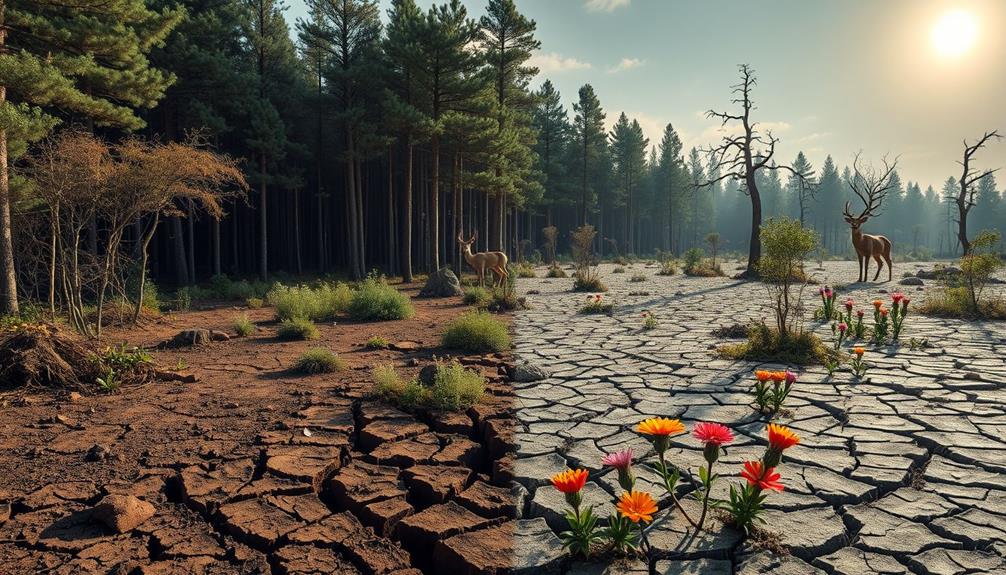
As you observe the effects of climate change, you'll notice how ecosystems are disrupted, leading to habitat loss for many species.
This not only forces wildlife to migrate but also invites invasive species that can threaten native populations.
For instance, the increased temperatures can impact aquatic environments, affecting species like fish and amphibians, which rely on stable conditions.
Understanding these changes is essential for finding effective solutions to protect our local environments, such as implementing eco-friendly products that can help mitigate further damage.
Ecosystem Disruption Effects
Climate change is reshaping ecosystems and habitats in profound ways, presenting significant challenges for local wildlife. Rising temperatures are causing ecosystem disruption, which leads to imbalances in species populations. As habitats change, many plants and animals must adapt to new environments where competition for resources intensifies. This habitat loss can threaten survival and drive species to extinction.
Engaging in healthy kid play not only promotes well-being but also fosters awareness of environmental issues among children. Understanding the importance of nature-based play can inspire future generations to protect local wildlife and their habitats.
Consider migratory birds; altered migration patterns due to climate fluctuations can disrupt their breeding cycles. For instance, if food sources don't coincide with their arrival, these birds may struggle to survive.
The marine food chain also suffers as warmer oceans hinder nutrient circulation, reducing phytoplankton, which is essential for marine life. This impacts the entire ecosystem, affecting everything from tiny fish to larger predators.
Additionally, some species face extreme threats; salmon in North America are experiencing decreased reproduction rates due to rising water temperatures.
The climate crisis not only disrupts individual species but also jeopardizes the intricate connections that sustain entire ecosystems. As you witness these changes in your local environment, remember that your awareness and actions can contribute to addressing this critical issue.
Habitat Loss Solutions
Finding solutions to habitat loss is essential for maintaining biodiversity and ecosystem health. As global temperatures rise and extreme climate events become more common, you can take action to help wildlife and restore balance in ecosystems.
One effective approach is habitat restoration, which involves rehabilitating degraded lands to create suitable environments for various species. Additionally, understanding the impact of mental health support on community well-being can enhance conservation efforts, as healthier communities are more likely to engage in and prioritize environmental initiatives.
Supporting local conservation efforts is also vital. By working together with local communities, you can help establish protected areas that safeguard essential habitats from further destruction. This collaborative effort not only benefits wildlife but also strengthens community ties and promotes sustainable practices.
Engaging in conservation and climate action initiatives can make a significant difference. Consider participating in tree-planting events or advocating for policies that prioritize habitat preservation. Remember, even small actions can lead to substantial impacts over time.
Ultimately, addressing habitat loss requires a collective commitment. By recognizing the importance of healthy ecosystems and taking steps to protect them, you contribute to the survival of countless species facing the threat of extinction.
Your efforts can foster resilience in natural environments, helping both wildlife and local communities thrive amid changing conditions.
Animal Health and Adaptation

In the face of changing environments, animal health and adaptation are increasingly intertwined with the effects of climate change. As habitats shift, many animals find themselves migrating to seek suitable conditions for survival. This movement can disrupt local ecosystems, leading to reduced biodiversity, which in turn increases competition for resources.
For some species, like those closely tied to their native environments, adapting to these rapid changes becomes a formidable challenge. Additionally, stress factors such as yoga for back pain management can also be applied metaphorically, as animals must find ways to cope with the physical and environmental stressors they encounter.
Invasive species often exacerbate this situation by introducing diseases that further threaten the health of native plants and animals. These new pressures put added stress on ecosystems already struggling with the impacts of climate change. Wildlife health suffers when seasonal events, such as food availability and breeding cycles, become mismatched due to altered climate patterns.
To help local wildlife adapt, you can support conservation efforts that promote biodiversity. By protecting natural habitats and minimizing the spread of invasive species, you contribute to healthier ecosystems. Your actions can play a crucial role in ensuring that both animal health and adaptation remain resilient in the face of climate change.
Nature-based Solutions for Conservation

As wildlife face increasing pressures from climate change, Nature-based Solutions (NbS) emerge as a powerful tool for conservation. These solutions leverage natural processes like reforestation and wetland restoration to support biodiversity and enhance ecosystem services.
Utilizing natural ingredients, like butter's nutritional benefits, can inspire sustainable practices in agriculture. By implementing NbS, you can play a significant role in climate adaptation and help local habitats thrive.
Here are a few impactful nature-based solutions you can support:
- Agroforestry: Integrating trees into agricultural landscapes boosts productivity and carbon sequester.
- Mangrove Restoration: Protecting and restoring mangroves safeguards coastal ecosystems while reducing storm impacts.
- Protected Areas: Establishing these areas provides safe habitats for wildlife and maintains essential ecosystem functions.
Investing in NbS can also create local jobs, contributing to economic stability. The Global Climate Action initiative is mobilizing funds, aiming to implement these solutions widely, especially in vulnerable regions.
With healthy ecosystems potentially providing 37% of the carbon reductions we need for climate goals, your support for nature-based solutions not only benefits our planet but also enhances resilience for wildlife in the face of climate challenges.
Let's embrace these strategies for a sustainable future.
Community Engagement Strategies
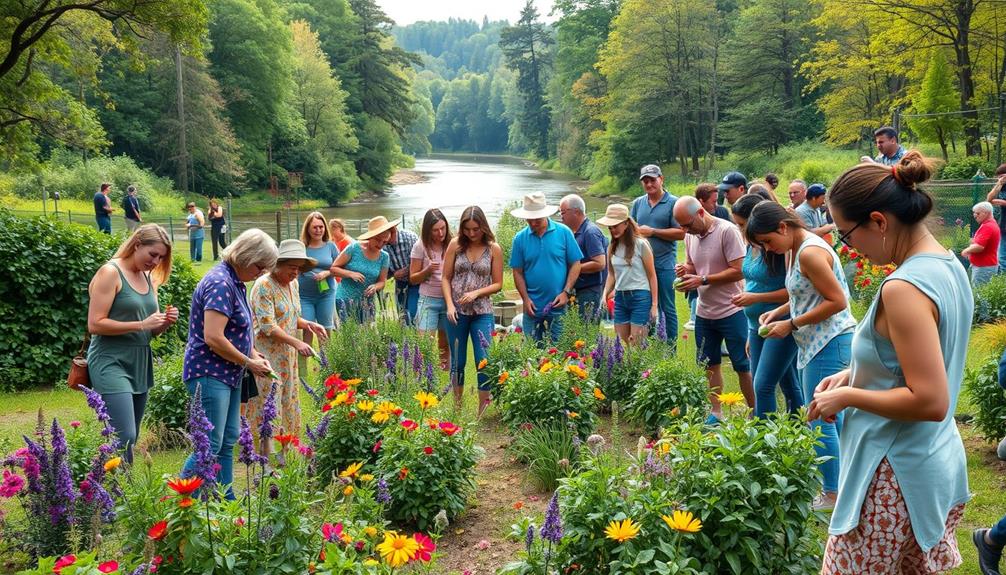
Community engagement strategies play a crucial role in wildlife conservation, ensuring that local needs align with environmental protection goals. When you actively participate in conservation efforts, you help foster a sense of stewardship for local ecosystems, much like how understanding BPD dynamics can enhance interpersonal relationships.
By getting involved in citizen science initiatives, you can contribute valuable data that enhances understanding of local wildlife and their habitats, making a real difference in conservation outcomes.
Advocating for pedestrian access and preserving natural spaces in your neighborhood not only encourages public support for wildlife protection but also benefits community well-being. Join local conservation groups that offer educational opportunities, empowering you and your neighbors to learn about biodiversity and effective conservation strategies.
These programs can deepen your connection to the environment while addressing pressing issues like wildlife crime by involving local populations in protecting their natural resources.
Ultimately, engaging your community in wildlife protection creates a collaborative approach to conservation. Together, you can make informed decisions that not only benefit local ecosystems but also strengthen your community.
Embrace these strategies and watch as your efforts contribute to a healthier environment for both wildlife and residents alike.
Actions Individuals Can Take

Taking action as an individual can make a significant impact on local wildlife and the environment. You have the power to help combat the effects of climate change and support wildlife in your community. Here are three actionable steps you can take:
- Plant native species: By planting native grasses, trees, and shrubs, you can absorb CO2 and create habitats that foster biodiversity.
- Reduce, reuse, recycle: These everyday actions lower your carbon footprint, directly influencing climate change and its impacts on wildlife.
- Volunteer: Get involved with local wildlife refuges or clean-up projects to restore habitats and conserve species threatened by climate-related changes.
Additionally, engaging in citizen science initiatives lets you contribute valuable data to environmental research.
Staying informed about climate change and participating in discussions with your local government empowers you to advocate for policies that protect natural spaces.
Every small action counts, and by taking these steps, you can help mitigate the impacts of climate change on local wildlife. Your involvement not only supports the ecosystem but also inspires others to join the cause.
Frequently Asked Questions
How to Help Wildlife With Climate Change?
You can help wildlife by planting native species, removing invasive plants, and creating pollinator gardens. Participate in local restoration projects and advocate for natural spaces to enhance ecosystem resilience against climate change's impacts.
What Impact Is Climate Change Having on Local Wildlife?
Climate change's impact on local wildlife is profound; rising temperatures and altered habitats force species to adapt or migrate. You'll see mismatched breeding seasons and increased competition, threatening survival for many native plants and animals.
How to Support Local Wildlife?
To support local wildlife, remember: "Many hands make light work." Plant native species, create pollinator gardens, volunteer for clean-ups, use reusable items, and advocate for conservation. Your efforts can truly make a difference in their habitats.
How Can We Solve Climate Change Locally?
You can solve climate change locally by planting native species, participating in community clean-ups, engaging in citizen science, advocating for renewable energy policies, and utilizing resources from organizations like the EPA and NOAA.
Conclusion
As you step outside, imagine vibrant forests teeming with life, where birds sing and butterflies dance in the sunlight. Yet, climate change threatens this delicate balance. By taking small actions, like planting native species or reducing waste, you can help protect these precious ecosystems. Picture a future where children marvel at the beauty of nature, their laughter echoing through lush landscapes. Your efforts today can nurture wildlife and guarantee that the symphony of nature continues for generations to come.
Dana is our Lead Content Writer, bringing a wealth of knowledge and expertise to our team. With a background deeply rooted in animal studies and a profound love for all creatures, Dana is dedicated to crafting engaging and informative content that resonates with our audience. With Dana at the helm, you can trust that our content is accurate and engaging, catering to the diverse interests of animal enthusiasts everywhere.
Animal Facts
Bird Breeding Record Keeping: Tips and Templates
Find out how effective record keeping can transform your bird breeding program and uncover essential tips and templates to enhance your success.

Keeping thorough records in bird breeding isn't just a task; it's the backbone of a successful program. You should track hatching rates, pairings, and any genetic traits. Use colored rings or digital tools like software for accuracy. Regular updates will help you spot patterns and make informed decisions. Templates for hatching records, breeding pairs, and treatment logs can streamline your efforts, making management easier. Don't underestimate the value of online communities for resources and support. By implementing these practices and tips, you'll see improvements in your breeding outcomes, and there's plenty more to explore on effective techniques.
Key Takeaways
- Accurate record keeping enhances breeding strategies by tracking lineage, health issues, and performance history of birds.
- Utilize both traditional methods, like hardbound books, and digital solutions, such as specialized software, for efficient record management.
- Implement identification techniques, including colored rings and unique identifiers, to monitor individual birds and their genetic backgrounds effectively.
- Maintain templates like hatching record charts and breeding pair records to streamline documentation and improve flock management insights.
- Regularly update and review records to analyze breeding outcomes and inform future pairings for better reproductive success.
Importance of Record Keeping
When you keep accurate records of your bird breeding activities, you not only track progress but also enhance your overall breeding strategy. Record keeping is an important part of successful breeding; it allows you to monitor hatching rates, pairings, and lineage effectively.
By maintaining organized records, you can identify genetic traits, health issues, and performance history, which are vital for making informed breeding decisions. Just as in vegan alternatives, where understanding the ingredients plays a key role, thorough documentation guarantees that you have all necessary information at your fingertips.
Documenting bird performance and achievements supports the overall management efficiency of your breeding operations, making it easier to evaluate which pairings yield the best results.
Regular updates and thorough documentation of breeding data lead to improved outcomes while fostering confidence in your ability to advise other breeders. When you keep records consistently, you build a reliable reference that enhances your breeding program.
Observation notes are only valuable when properly documented, emphasizing the need for solid record-keeping methods.
By focusing on this essential aspect of breeding, you not only enhance your own practices but also contribute positively to the broader breeding community.
Effective Record-Keeping Methods

When it comes to record-keeping for your bird breeding program, you've got options—traditional methods like hardbound books or digital tools like Zooeasy.
Utilizing effective goal tracking techniques can enhance your record-keeping process by guaranteeing that your objectives are clear and measurable.
It's essential to implement identification techniques, such as toe punches and pen tags, to track individual birds effectively.
Traditional Vs. Digital Methods
Effective record-keeping methods in bird breeding often boil down to two primary approaches: traditional and digital. Traditional methods, like hardbound books and notebooks, offer reliability and portability, making it easy for you to access breeding details and observations quickly. They're particularly useful for jotting down notes in the field or during breeding sessions. However, they can become cumbersome as your breeding program expands.
Additionally, just as with tracking feline behavior and health, maintaining detailed records is essential for identifying patterns and making informed decisions in your breeding practices. Cat health and nutrition can also be an important aspect to take into account when ensuring the well-being of your birds.
On the other hand, digital options like Zooeasy and Evans Software streamline your record management. These platforms allow you to track lineage, health issues, and breeding outcomes more efficiently, saving you time and reducing the chance of errors. Utilizing colored rings and leg bands for bird identification complements both methods, enhancing tracking accuracy.
You might also find that combining progressive photos with detailed notes can serve as effective tools for visual tracking of your birds' development and traits over time.
Regardless of the method you choose, remember that both traditional and digital systems require regular updates and backups to prevent data loss and maintain consistent record accuracy. Ultimately, the best approach aligns with your preferences and the scale of your breeding program.
Essential Identification Techniques
In the domain of bird breeding, employing vital identification techniques greatly enhances your record-keeping efforts. Using colored rings on your birds can indicate hatch year and breed, making it easier to track and identify individuals within your breeding records. This simple method streamlines your process and guarantees accuracy, much like how understanding BPD can improve relationships.
Implementing leg bands for each bird allows for straightforward monitoring of lineage and breeding history. By assigning unique identifiers, you can easily document each bird's progress and genetic background, which is fundamental for informed breeding decisions.
Additionally, consider using toe punches and numbered pen tags, as they provide reliable identification methods, especially when paired with detailed records. Keeping a combination of photographs and notes further aids in tracking developmental traits and health status over time, giving you a visual reference for breeding evaluations.
Don't forget to regularly update your records with information about individual bird behavior and health. This thorough tracking guarantees effective management of your breeding stock and allows for better decision-making in your breeding program.
Essential Tools and Equipment

To effectively manage your bird breeding program, you'll need essential tools like identification tags and rings.
These items not only help you track individual birds but also simplify your record-keeping process.
Additionally, you may want to incorporate practices from a professional cleaning service, such as having a flexible scheduling option for maintaining a clean environment for your birds.
Consider digital solutions for organizing your data, making it easier to access and update when necessary.
Identification Tags and Rings
Identification tags and rings play an essential role in bird breeding record keeping, providing crucial tools for managing your breeding program.
Colored rings are particularly useful, as they indicate the hatch year and breed information, allowing for quick visual identification of individual birds. This can save you time and effort when monitoring your flock.
Understanding dog health and nutrition can also enhance your overall approach to breeding, ensuring your birds remain healthy and well-cared for.
Leg bands offer a reliable method for tracking and identifying each bird, ensuring your record-keeping remains accurate and organized. For permanent identification, consider using toe punches; they help maintain accurate breeding records over time, even as your birds mature.
You might also find numbered pen tags beneficial; attaching these to birds simplifies tracking and facilitates documentation of breeding pairs and lineage.
By combining various identification methods like rings, leg bands, and photographic records, you'll enhance your ability to monitor bird development and breeding history effectively.
Using these tools won't only streamline your record-keeping process but also improve your overall understanding of your birds' genetics and lineage, helping you make informed decisions in your breeding program.
Digital Record-Keeping Solutions
Keeping accurate records is essential for any bird breeding program, and digital solutions can greatly enhance your efficiency. Specialized software like Zooeasy offers user-friendly interfaces that help you track breeding details, bird health, and lineage without hassle.
By utilizing mobile apps and cloud storage, you can easily access and back up crucial breeding records, ensuring your data is protected and available across various devices. Additionally, it's important to protect your savings by being cautious of scams, much like the need for credibility in bird breeding tools—avoid Gold IRA scams.
Programs like Evans Software streamline data entry, making it easier to document key information such as pairings, hatch rates, and individual bird behavior. This saves you time and reduces the risk of errors in your records.
Additionally, incorporating spreadsheets into your digital management allows for enhanced data analysis. You can visualize trends over time, helping you make informed breeding decisions.
Don't overlook online forums and community groups, either. They can provide valuable insights and recommendations for the best digital tools tailored to your specific breeding needs and challenges.
Breeding Strategies to Document

When planning your bird breeding strategies, it's essential to document key practices that can greatly impact your flock's success. Start by keeping your chickens in pairs or trios, as this enhances breeding management and increases the likelihood of successful pairings.
Make a note of these arrangements, as well as any notable interactions between birds. Additionally, understanding the importance of mental health support can be beneficial, as a calm environment promotes better breeding outcomes.
Regular culling of roosters, ideally at least four times a year, is critical for maintaining a strong genetic line. Document which roosters you've culled and the reasons behind your decisions; this will help you refine your breeding choices over time.
Understanding genetics and traits is equally important; record your observations to make informed decisions about future pairings.
Pay attention to early signs of developmental faults or merits. Documenting these observations allows you to adjust your strategies proactively.
Finally, keep meticulous records of vaccinations and show performances for your breeder birds. This information helps you track their health and performance, ultimately contributing to improved breeding outcomes.
Learning From Breeding Outcomes

To truly capitalize on your bird breeding endeavors, you need to immerse yourself in the outcomes of each breeding cycle. Continuous observation of these outcomes allows you to identify successful traits and faults, helping you make better breeding decisions.
Documenting the performance of your breeding pairs over time is essential; it helps you assess genetic traits and their influence on the quality of your offspring. Incorporating systematic record keeping can streamline this process, making it easier to track yoga for back pain management and identify trends.
Regularly reviewing hatching rates and chick development gives you insights into overall reproductive success and highlights areas needing improvement. You should analyze patterns from past breeding outcomes, as this can inform your strategic pairings and increase the likelihood of desirable traits in future generations.
Utilizing photographs alongside your notes on developmental progress can greatly aid your efforts. Visual tracking of traits allows you to make informed decisions based on historical data, further enhancing your breeding program.
Online Resources for Record Keeping
Utilizing online resources can greatly enhance your bird breeding record keeping. Online forums and communities are gold mines for insights and best practices shared by fellow breeders. You can learn effective strategies and tips that can streamline your record-keeping processes, especially when considering the importance of AI advancements in improving data management practices.
Programs like Zooeasy provide specialized tools designed specifically for tracking poultry and waterfowl records. These platforms guarantee that you have easy access to essential breeding data, making your record keeping more efficient. Additionally, you can find downloadable templates and charts covering various aspects, such as egg production and breeding pair evaluations, which can save you time and effort.
Consider using cloud storage solutions to securely manage and back up your records. This way, you can access your data from multiple devices without the fear of losing it.
Furthermore, extensive articles and guides on avian breeding and management are available online to deepen your knowledge and improve your record-keeping methods. By leveraging these online resources, you'll not only enhance your efficiency but also gain valuable insights that can contribute to the success of your bird breeding endeavors.
Templates for Efficient Tracking
Effective tracking of your bird breeding activities can considerably improve your management practices. By utilizing specific templates, you can streamline your record-keeping and enhance your understanding of your flock.
Here are four important templates you should consider implementing:
- Hatching Record Chart: This helps you systematically track hatch rates, dates, and any issues with poor hatches. It's essential for your reproductive management.
- Breeding Pair Records: Document each breeding pair's hatch rates and types. This aids in evaluating their performance over time and making informed decisions for future pairings.
- Flock Inventory Chart: Keep detailed records of your flock's comings and goings, including sales and purchases. This is significant for managing flock size and composition effectively.
- Treatment Records Log: Document illnesses, treatments, and symptoms for each bird. This facilitates better health management and provides valuable future references.
Frequently Asked Questions
What Is the Best Way to Record Birds?
To record birds effectively, use a mix of hardbound books for reliability and digital software for ease. Incorporate colored rings for identification and document details through notes and photos to track development and traits efficiently.
What Is the Bird Breeding Record App?
The Bird Breeding Record App simplifies tracking your breeding pairs, hatch rates, and lineage. It offers customizable templates, photo uploads, and reminders, making it easier for you to manage your birds efficiently and effectively.
How Profitable Is Bird Breeding?
Bird breeding can be quite profitable, with earnings varying based on species and demand. By managing expenses wisely and enhancing your online presence, you can maximize your sales and attract more customers effectively.
What Are Bird Breeding Codes?
Imagine a librarian organizing books; bird breeding codes serve that purpose for avian enthusiasts. They're alphanumeric identifiers that help you track breeds, traits, and lineage, making your breeding decisions clearer and more informed.
Conclusion
In the vibrant tapestry of bird breeding, your records are the threads that weave success. By keeping meticulous notes, you're not just tracking progress; you're painting a picture of growth and learning. Each entry captures the melody of your efforts, turning challenges into symphonies of knowledge. Embrace these tools and strategies, and watch as your avian family flourishes. Remember, in the dance of life, the more you document, the more beautiful the performance becomes.
Dana is our Lead Content Writer, bringing a wealth of knowledge and expertise to our team. With a background deeply rooted in animal studies and a profound love for all creatures, Dana is dedicated to crafting engaging and informative content that resonates with our audience. With Dana at the helm, you can trust that our content is accurate and engaging, catering to the diverse interests of animal enthusiasts everywhere.
Animal Facts
Squirrel-Friendly Garden Ideas: Coexisting With Backyard Wildlife
Create a vibrant squirrel-friendly garden that delights wildlife, but what clever strategies can you implement to ensure harmony and protect your plants?

To create a squirrel-friendly garden, start by providing alternative food sources like sunflower seeds and unroasted peanuts. This keeps squirrels entertained and distracted from your plants. Use squirrel-resistant bulbs and bury them deep to minimize digging. Employ physical barriers like chicken wire around your beds to protect young plants. You can also use scent-based deterrents, such as blood meal, to keep squirrels at bay. By fostering this coexistence, you enhance biodiversity and enjoy the playful antics of your backyard visitors. There's much more you can do to create a lively and harmonious garden environment.
Key Takeaways
- Create dedicated bird feeders to entertain squirrels and prevent them from damaging your plants while enjoying the wildlife.
- Incorporate squirrel-resistant plants like daffodils and allium to protect your garden while still attracting squirrels.
- Provide alternative food sources, such as sunflower seeds and unroasted peanuts, to redirect squirrels' attention away from your plants.
- Use natural materials and promote healthy plant growth to create a thriving ecosystem that supports both gardens and wildlife.
- Install physical barriers like chicken wire around garden beds to protect young plants while allowing for the presence of playful squirrels.
Coexistence Strategies With Squirrels
Creating a vibrant garden while sharing space with squirrels can be a delightful challenge. To coexist peacefully, you can implement strategies that redirect their attention from your precious plants. Since squirrels consume about a pound of food weekly, providing alternative food sources like sunflower seeds or unroasted peanuts at ground level can keep them occupied.
Additionally, using natural materials in your garden design, such as well-draining soil, can help promote healthy plant growth while minimizing the impact of local wildlife.
Setting up dedicated bird feeders filled with these treats encourages playful behavior, adding a lively atmosphere to your garden. These feeders not only entertain you but also help prevent squirrels from damaging your flowers and vegetables.
You'll find that active year-round feeding creates a buffer against potential harm to your young perennials in the spring as squirrels seek out food sources.
Incorporating trees and shrubs in your garden can further support this coexistence. These natural food sources can offer squirrels a place to forage without interfering with your plants.
Additionally, providing clean water sources like small birdbaths can enhance their experience and promote a harmonious relationship. Observing their antics can make gardening even more enjoyable for everyone, turning potential nuisances into delightful companions in your backyard.
Plant Protection Techniques

Protecting your plants from squirrels requires a blend of strategic choices and practical techniques. Start by selecting bulbs that squirrels tend to avoid, such as daffodils, allium, and fritillaries. These can be planted alongside more vulnerable options like tulips.
When planting, make sure to bury your bulbs deep in the soil. This not only makes it harder for squirrels to dig them up but also encourages healthy growth. Additionally, incorporating natural materials like stone and wood in your garden can create an inviting atmosphere that attracts other wildlife, which can help to deter squirrels from your plants elements for farmhouse dining room style.
Another effective method is to use chicken wire to cover newly planted bulbs. This allows your plants to thrive while deterring squirrels from accessing them.
Additionally, pay attention to seasonal patterns; choosing the right planting time can greatly influence squirrel activity in your garden.
Regularly remove any bulb debris, as this minimizes the attraction for squirrels searching for food. By creating a garden environment that also attracts birds and other wildlife, you'll enhance the ecosystem around your trees and plants, further discouraging squirrels.
With these techniques, you can enjoy a flourishing garden while coexisting peacefully with your backyard wildlife.
Scent-Based Deterrents

Scent-based deterrents can be an effective way to keep squirrels away from your garden. By utilizing strong odors, you can disrupt their foraging behavior and encourage a more harmonious coexistence.
Here are three scent-based deterrents you can try:
- Chicken Manure Pellets: The smell of chicken manure pellets is known to repel squirrels, making them a great addition to your garden.
- Blood Meal: This product emits a strong scent that can deter squirrels and help protect your valuable plants from their nibbling.
- Coyote Urine or Dog Urine: These natural repellents play on squirrels' territorial instincts, making them think predators are nearby, which can keep them at bay.
Physical Barriers for Protection

When it comes to safeguarding your garden from pesky squirrels, employing physical barriers can be a game changer. You can start by installing baffles on your bird feeder. These devices create a physical barrier that prevents squirrels from accessing the food, allowing birds to feed without competition.
If you want to go further, consider constructing metal cages around your feeders to limit those squirrel raids and protect your birdseed from being stolen. Additionally, using tough dog names can serve as a fun reminder of your furry friends while you work in your garden.
For your garden beds, strategically placing barriers like chicken wire can protect young plants and bulbs from being dug up or eaten. Covering newly planted bulbs with wire not only protects them during growth but also allows air and moisture to reach the plants while deterring squirrels.
Remember, squirrels need to find food and nesting sites, so being proactive with these barriers can greatly minimize wildlife activity in your garden.
Regularly checking and maintaining these physical barriers is essential to guarantee their effectiveness. By staying vigilant, you can create a protective shield around your garden, allowing you to enjoy its beauty while coexisting with nature.
Benefits of Squirrel-Friendly Gardens

Creating a squirrel-friendly garden not only helps mitigate the challenges posed by these agile critters but also brings a host of benefits to your outdoor space. By designing your garden with squirrels in mind, you can enhance biodiversity and create a thriving ecosystem.
Engaging in family activities that promote creativity, such as gardening, can also encourage children to develop a deeper appreciation for nature and wildlife family activities that promote creativity.
- Improved Biodiversity: Attracting various species supports a balanced ecosystem. Different animals contribute to the health and stability of your garden.
- Natural Food Sources: Providing squirrels with nuts, seeds, and fruits guarantees they've the nourishment they need. This, in turn, encourages other wildlife to visit, enriching your garden's habitat.
- Pest Control: Squirrels serve as natural pest controllers, munching on insects and helping maintain a healthy garden. Their presence can reduce the need for chemical pesticides.
In addition to these benefits, incorporating squirrel-friendly elements like feeders and nesting boxes creates an enjoyable environment for both you and the critters.
Watching playful squirrels can improve the aesthetics of your outdoor space and entertain your family. By embracing a squirrel-friendly approach, you're fostering a lively, diverse, and sustainable garden.
Frequently Asked Questions
How to Coexist With Squirrels?
To coexist with squirrels, you can create feeding stations, use barriers to protect plants, and implement scent deterrents. Encouraging natural habitats and limiting competition for food helps maintain harmony between you and these playful animals.
How Do I Make My Backyard Squirrel Friendly?
To make your backyard squirrel-friendly, set up feeders with sunflower seeds, plant non-preferred bulbs, and create brush piles for shelter. Deep planting and using chicken wire can help protect your favorite plants from squirrels.
What Plants Do Squirrels Hate the Most?
Think of your garden as a fortress. To keep squirrels at bay, plant daffodils, allium, and marigolds. Incorporating strong herbs like rosemary and bitter foliage can also make your garden unappealing to these critters.
How to Live in Harmony With Squirrels?
To live in harmony with squirrels, provide alternative food sources, install dedicated feeders, and use scent deterrents. Plant non-preferred bulbs, and enjoy observing their antics—this fosters a balanced relationship with these playful creatures.
Conclusion
By embracing squirrel-friendly garden ideas, you not only create a thriving habitat but also enjoy the company of these playful critters. Did you know that a single squirrel can bury up to 25 acorns in a day? Imagine the joy of watching them scurry around, hiding their treasures! With the right coexistence strategies, you can protect your plants while fostering a lively ecosystem in your backyard. It's a win-win for both you and your furry neighbors!
Dana is our Lead Content Writer, bringing a wealth of knowledge and expertise to our team. With a background deeply rooted in animal studies and a profound love for all creatures, Dana is dedicated to crafting engaging and informative content that resonates with our audience. With Dana at the helm, you can trust that our content is accurate and engaging, catering to the diverse interests of animal enthusiasts everywhere.
-

 Vetted6 months ago
Vetted6 months ago15 Best Dog Food Brands Recommended by Vets for Healthy and Happy Pups
-

 Vetted6 months ago
Vetted6 months ago15 Best Affordable Dog Foods That Won't Break the Bank
-

 Cats5 months ago
Cats5 months agoCat Weight Chart by Age: Kitten to Senior in Lbs
-

 Vetted6 months ago
Vetted6 months ago14 Best Homemade Dog Food Recipes Your Pup Will Love – Vet Approved & Nutritious
-

 Vetted6 months ago
Vetted6 months ago15 Best Cat Foods for Managing Hyperthyroidism – Vet Approved and Feline Friendly
-

 Vetted6 months ago
Vetted6 months ago15 Best Dog Foods for Kidney Disease – Expert Recommendations for Your Pet's Health
-

 Vetted6 months ago
Vetted6 months ago15 Best Affordable Cat Foods That Won't Break the Bank
-

 Vetted6 months ago
Vetted6 months ago15 Best Vet-Recommended Dry Cat Foods for Indoor Cats – Keep Your Feline Friend Happy and Healthy

































